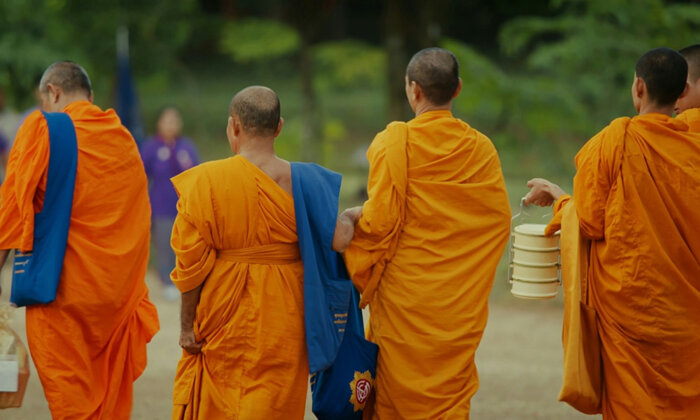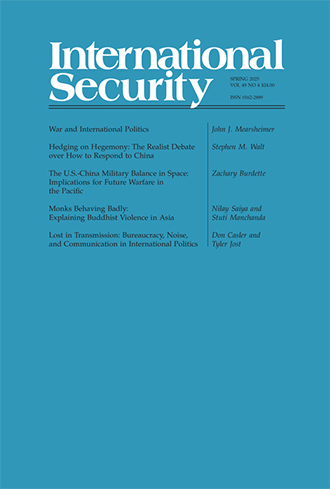Monks Behaving Badly: Explaining Buddhist Violence in Asia

According to the Pew Research Center, about one-quarter of countries worldwide exhibit “high” or “very high” levels of social hostilities involving religion, including violent religion-related attacks. We’re seeing this play out globally. A new wave of religious violence across the Middle East commenced with the devastating attack by Hamas against Israel on October 7, 2023. Sectarian conflicts continue to simmer in countries as diverse as India, Indonesia, Nigeria, and Vietnam. In the United States and Europe, a rising tide of hate crimes against Jews and Muslims shows that religious violence is by no means limited to the developing world. As of 2025, possible genocides against communities of faith are unfolding in China and in Myanmar. In many ways, religious violence is surging alongside a broader global resurgence of religion itself.

The dramatic rise in religious violence since the end of the Cold War has spawned a cottage industry of scholarship, popular books, punditry, and policy analysis that attempts to explain, prevent, or combat violent religion-related extremism. Much of the attention to religious violence in the modern world has focused on Islam, but many scholars are also turning their focus to violence in Christianity, Hinduism, and Judaism.
Yet violence in one of the world’s major religious traditions — Buddhism — has received far less attention. Of the world’s major faith traditions, Buddhism is the one most commonly associated with peace, tolerance, and compassion, nonviolence being one of its most defining features. This view makes it a seemingly difficult case for any theory linking religion and violence. Yet like every other major religious tradition, Buddhism has a violent side that belies the stereotype of it being an “exclusively pacifist” and “irenic” religion.1
The stereotype of Buddhism as uniquely committed to nonviolence exudes a type of “positive Orientialism,” which assumes that a non-Western religion should be more committed than Western Christianity to its original nonviolent teachings.2 Such a view also belies the historical reality of violence within Buddhism. As Ian Harris notes, “Any presentation of Buddhism as a tradition that focuses on its quietist, meditation-orientated dimension alone will necessarily be one-sided.”3
Consider several historical examples. Buddhist soldiers in sixth-century China achieved the noble “status of bodhisattva” for killing their enemies. In feudal Japan, warrior Buddhist monks known as the Sohei used force to defend territory and fight against those associated with rival schools of Buddhism. In 16th-century Thailand, Buddhist holy men staged bloody revolts against the government. During World War II, Zen Buddhism provided a strong foundation for Japanese militarism, including Imperial Japan’s use of suicide warfare.
Since the turn of the century, Buddhist violence has occurred in eight of 11 countries where Buddhists make up the largest religious group.
More recently, Buddhist actors have justified and carried out violence, especially in the Buddhist-majority states of South and Southeast Asia, where distinctively Buddhist forms of violent nationalism have collided with minority faith traditions. One of the most serious acts of terrorism in the modern world involved a deadly chemical weapons attack in 1995 on the Tokyo subway system, carried out by a Japanese doomsday cult with roots in Buddhism called Aum Shinrikyo. During the political unrest that gripped Tibet in 2008, hundreds of Buddhist monks participated in riots that killed dozens of people. Buddhist violence figured prominently in a decades-long civil war in Sri Lanka, and it plays a crucial role in an ongoing ethnic cleansing campaign in Myanmar and in simmering conflicts in other parts of Asia.
Since the turn of the century, Buddhist violence has occurred in eight of 11 countries where Buddhists make up the largest religious group, including large-scale violent persecutions of minorities. Militant Buddhists have also supported violence in countries where Buddhists are not the majority. For example, in 2022, the head of the largest Buddhist denomination in Russia voiced support for Russia’s invasion of Ukraine.
Although scholars such as Michael Jerryson, Mark Juergensmeyer, and Stanley Tambiah acknowledge Buddhist violence in their work, little scholarship has attempted to put forth generalizable and testable propositions for why Buddhism turns violent in some countries but not in others.
In our recent article published in the journal International Security — the broader arguments of which we outline here — we draw on religious market theory, which holds that religious participation tends to rise in societies where there is competition among diverse religious groups as opposed to religious monopolies, to propose what we believe is the simplest and most comprehensive explanation of Buddhist violence: an institutional account rooted in the relationship between temple and state in Buddhist-majority countries. Essentially, Buddhist violence has stemmed from a political bargain between Buddhism and the state. Owing to Buddhism’s ubiquitous social prestige in Buddhist-majority countries, some governments have sought to co-opt it for political gain. In return, Buddhist monks have increasingly looked to their governments to promote Buddhist values, maintain social order, and perpetuate the purity and legitimacy of the Buddhist state. The mutually reinforcing relationship between temple and state means that Buddhism has become complicit in the violence of the state and the state in the violence that radical Buddhists have carried out.
Scholars of global religion have long recognized a striking paradox: Faiths that proclaim a message of peace and love can also become implicated in the murder of innocent civilians. They label this contradiction “the ambivalence of the sacred.” To say that religion is politically ambivalent means that it is fundamentally malleable and can be used to support myriad political positions — even contradictory ones like violence and peace. Although scholars acknowledge the ambivalent nature of religion, less attention has been paid to why religion is sometimes prone to violence and at other times prone to peace. For any religion to become embroiled in violence, latent spiritual views must somehow become politically activated. What kinds of environments encourage or discourage religious violence?
Of particular importance is how religious and political institutions interact. In a pioneering work, Daniel Philpott argued that religious ideology interacts with governmental treatment of religion to produce religious violence in the forms of communal conflict and terrorism. Religious groups that operate independently of the state and embrace a political theology aligned with tolerance and liberalism, he found, tend to support democracy, peace, and reconciliation. Conversely, those with close state ties and theologies that legitimize violence are more inclined to endorse authoritarianism and the use of force to achieve their objectives. Building on Philpott’s work, other scholars have applied the idea of religion-state arrangements to the study of religious violence, including civil wars, terrorism, and mob violence.4
While there are multiple ways that government and religion can become entangled, arguably the most important entanglement is a religion-state arrangement sometimes dubbed “religious favoritism,” or state support for religion. Religious favoritism can be understood as an implicit bargain between historically and culturally dominant religious communities and political elites. Religious actors in these states pledge their allegiance to certain political leaders, believing that they will uphold religious purity and protect the majority’s dominance over minorities and newcomers.
For their part, political leaders have institutional incentives to favor majority faith traditions — doing so reinforces their rule and imbues their preferred policies with an aura of spiritual transcendence. These leaders may not be religious themselves, but they covet the benefits of allying with dominant religions. Religious identity thus becomes weaponized from both sides to exclude nonprivileged individuals and communities from citizenship and political representation, and from having a role in determining public policy.
This dynamic exists in the Buddhist world. Muslim minorities, in particular, have suffered disproportionately from Buddhist nationalism. That Buddhist-majority countries have marginalized Muslims reflects not only local developments but global realities, including the proliferation of extremist Islamist movements and global Islamophobia. Thus, the securitization of Islam has affected not only the Christian countries of the West but the Buddhist countries of the Far East.
Why does favoritism encourage religious violence? Essentially, religious favoritism makes religious divisions more intense. In these settings, political and religious leaders often work together to stifle dissenting beliefs, coerce religious conformity, and weaken the forces of moderation. When the government supports a particular (again, usually historically dominant) religious tradition while repressing minority groups, it can radicalize people within the majority group who see this favoritism as a green light for their own extreme views.
Paradoxically, it is often politically empowered religious groups, not marginalized ones, that justify attacking out-groups, even as they attempt to portray themselves as victims of minority encroachment. This is not to suggest that disempowered religious minorities are not also violent. Our point is that majoritarian vigilantism represents a more prevalent and often overlooked form of violence in the modern world. In Buddhist countries, the passage of anti-minority laws and policies — prohibiting proselytizing and conversion, restricting interreligious marriage, regulating religious dress, and forcing dead bodies to be cremated — has coincided with Buddhist attacks, particularly against Muslims.
The inverse also holds: Countries with disentangled political systems and greater religious freedom tend to experience fewer problems with religious violence. Violence becomes less likely because extremists have little reason to think that the state will not punish their actions.60 Such environments also foster open debate, making it harder for radical ideologies to go unchallenged. In these contexts, extremists find their arguments critiqued in the marketplace of ideas, thus reducing the likelihood of individuals accepting the radical narrative. The need to put out a “good product” in these religious marketplaces makes religious groups less likely to turn to the gun, because doing so would repel existing members of that faith and deter potential converts.
The relationship between religious favoritism and religious violence is not always unidirectional; religious and state institutions interact in complex, ever-changing, and mutually reinforcing ways. Religious violence can prompt states to double down on favoritism, especially when majoritarian groups demand protection. In turn, this support can escalate conflict — a feedback loop of favoritism and violence. Governments may justify further favoritism as a response to unrest they helped provoke.
Importantly, this perspective on religious violence does not single out any particular faith tradition or religion more generally as being inherently prone to violence. Rather, it suggests that religious violence is the result of political arrangements rather than certain faith beliefs. In theory, any religion, even one as seemingly pacifist as Buddhism, can become violent under the right circumstances. Just as scholars have long scrutinized the relationship between Islam and the state, there’s no reason to assume Buddhism is immune to similar temptations.
This theoretical framework recognizes that other factors help produce Buddhist violence. Scholars of religion and violence show how religiously motivated violence is a multidimensional phenomenon rooted in myriad historical, ideological, sociopolitical, and psychological factors.5
Still, we believe that there are discernible patterns to this violence. Our theory — developed more fully through case studies of Myanmar, Sri Lanka, Thailand, and Singapore in our article — proposes a structural explanation for such violence, arguing that religious favoritism is a primary cause of majoritarian violence in Buddhist-majority countries.
Religious favoritism often has a dark side — it can provide a pretext for majoritarian vigilantes to attack religious minorities.
We believe our study makes important contributions to the field of religion and violence. First, it broadens the discussion of religious violence. Since at least the terrorist attacks of September 11, 2001, the vast majority of scholarly works have focused on Islam. In contrast, social scientists have not subjected Buddhism to much systematic treatment. Our theory and findings call on social scientists to take Buddhist violence seriously. We also aim to move the discussion of religious violence beyond that of religious ideas. Of course, religious actors’ beliefs about the use of force and the morality of doing so matter greatly in understanding faith-based violence. But focusing on the ethical or doctrinal content of religion alone cannot build generalizable theories regarding the causes of such violence.
Our argument and findings carry important insights for policymakers in Buddhist-majority countries and beyond. Political elites often believe that they can bolster government legitimacy, cultivate social trust, decrease religious grievances, and avert violence by favoring a historically and culturally dominant religious community. Yet, as we show, religious favoritism often has a dark side — it can provide a pretext for majoritarian vigilantes to attack religious minorities. In countries marked by the privilege of historically and culturally dominant faith traditions, religious vigilantes can claim that they act to uphold the law, even as their actions destroy social harmony, disrupt the economy, and promote instability and insecurity. Consequently, policies grounded in religious privilege end up being counterproductive, creating the very ills they are designed to prevent.
In the cases of Myanmar and Sri Lanka surveyed, the government sometimes tried unsuccessfully to stem episodes of interreligious violence that it had helped unleash but had spiraled out of control. Our findings suggest that states would be better off pursuing policies grounded in religion-state separation, religious equality, and freedom of religion. Indeed, our study contributes to a growing literature on the nature and value of regimes of religious toleration.6 The hope thus lies in the possibility that religious and state actors may, out of self-interest, reconsider the notion that alliances between religion and the state are beneficial. Such a recognition might address one of the key factors behind the global rise in religious violence that has blighted much of the 21st century.
Nilay Saiya is an Associate Professor of Public Policy and Global Affairs at Nanyang Technological University, Singapore. Stuti Manchanda is a Ph.D. graduate of public policy and global affairs at Nanyang Technological University, Singapore.
This article is adapted from their longer study, “Monks Behaving Badly: Explaining Buddhist Violence in Asia,” published in the Spring 2025 issue of the journal International Security.
- Michael K. Jerryson, “Buddhist Traditions and Violence,” in Mark Juergensmeyer, Margo Kitts, and Michael K. Jerryson, eds., “The Oxford Handbook of Religion and Violence” (New York: Oxford University Press, 2013).
- Vladimir Tikhonov and Torkel Brekke, eds., “Buddhism and Violence: Militarism and Buddhism in Modern Asia” (New York: Routledge, 2013).
- Ian Harris, ed., “Buddhism and Politics in Twentieth-Century Asia” (London: Continuum, 1999), p. vii.
- Nil S. Satana, Molly Inman, and Jóhanna Kristín Birnir, “Religion, Government Coalitions, and Terrorism,” Terrorism and Political Violence, Vol. 25, No. 1 (2013), pp. 29–52, https://doi.org/10.1080/09546553.2013.733250; Nilay Saiya, “The Religious Freedom Peace,” International Journal of Human Rights, Vol. 19, No. 3 (2015), pp. 369–382, https://doi.org/10.1080/13642987.2015.1032268; Nilay Saiya and Anthony Scime, “Explaining Religious Terrorism: A Data-Mined Analysis,” Conflict Management and Peace Science, Vol. 32, No. 5 (2015), pp. 487–512, https://doi.org/10.1177/0738894214559667; Nilay Saiya, “Religion, Democracy and Terrorism,” Perspectives on Terrorism, Vol. 9, No. 6 (December 2015), pp. 51–59, https://pt.icct.nl/article/religion-democracy-and-terrorism; Nilay Saiya, “Weapon of Peace: How Religious Liberty Combats Terrorism” (New York: Cambridge University Press, 2018).
- James A. Aho, “This Thing of Darkness: A Sociology of the Enemy” (Seattle: University of Washington Press, 1994); Mark Juergensmeyer, “Terror in the Mind of God: The Global Rise of Religious Violence” (Berkeley: University of California Press, 2003); Mark Juergensmeyer, “Global Rebellion: Religious Challenges to the Secular State,” from “Christian Militias to al Qaeda” (Berkeley: University of California Press, 2008); Jessica Stern, “Terror in the Name of God: Why Religious Militants Kill” (New York: HarperCollins, 2003); Bruce Hoffman, “Inside Terrorism” (New York: Columbia University Press, 1998).
- Thomas F. Farr, “World of Faith and Freedom: Why International Religious Liberty Is Vital to American National Security” (New York: Oxford University Press, 2008); Nilay Saiya, “Explaining Religious Violence Across Countries: An Institutional Perspective,” in Kevin R. den Dulk and Elizabeth A. Oldmixon, eds., “Mediating Religion and Government: Political Institutions and the Policy Process” (New York: Palgrave, 2014), pp. 209–240; Nilay Saiya, “Religious Freedom, the Arab Spring, and U.S. Middle East Policy,” International Politics, Vol. 54 (2017), pp. 43–53, https://doi.org/10.1057/s41311-017-0021-4; Nilay Saiya and Joshua Fidler, “Taking God Seriously: The Struggle Against Extremism,” Middle East Policy, Vol. 25, No. 1 (Spring 2018), pp. 80–95, https://doi.org/10.1111/mepo.12326.



